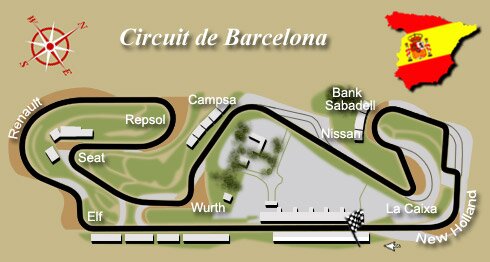The 2014 cars are, weight corrected, already almost matching the pace of 2004 (IMHO).
As proposed evidence, the fastest times ever and in 2014 (We can now include Brasil and we know what happened). Many of these records are from 2004, and of course, yes, the tracks have changed in many ways (and we also know that Brasil has new tarmac, yes).
So, I said weight corrected. An often cited figure is that every 10 Kg of weight cost 0.3s in lap time, so from the current 691kg to the 605kg from 2004, that is about 2.5 seconds, and hence why I say that they are about there now. This last weekend at Interlagos is probably quite skewed by the new tarmac, and yes, the turbo helps in altitude, but I haven't seen any rule that says that tracks have to be at sea level, and next year we'll have a race at much higher altitude, a race that used to be in the F1 calendar not that long ago.Blanchimont wrote:This table shows the overall lap record, the fastest time during the 2014 weekend and the differences in [s] and [%]. Australia, Malysia, China, Silverstone and Spa were wet qualifyings if i remember right.
Austral 1:23,529 1:29,375 5,846 7,00% Malays 1:33,074 1:39,008 5,934 6,38% Bahrain 1:30,139 1:33,185 3,046 3,38% China 1:32,238 1:38,315 6,077 6,59% Spain 1:19,995 1:25,232 5,237 6,55% Monaco 1:13,556 1:15,989 2,433 3,31% Canada 1:12,275 1:14,874 2,599 3,60% Austria 1:07,908 1:08,759 0,851 1,25% GreatBr 1:29,607 1:34,508 4,901 5,47% Germany 1:13,306 1:16,540 3,234 4,41% Hungary 1:18,773 1:22,715 3,942 5,00% Belgium 1:44,503 1:49,189 4,686 4,48% Italy 1:20,089 1:24,109 4,020 5,02% Singap 1:42,841 1:45,681 2,840 2,76% Japan 1:29,599 1:32,506 2,907 3,24%
Now I am slowly getting to the question: 2004 cars are often cited as having more downforce than 2014 cars, and in many cases it is quite evident. I think a figure for discussion could be that there is 1g of difference in the fastest corners. The weight difference does not quite account for that much, so more downforce in 2004.
So, the 2004 cars were faster in the corners, could brake later and could in principle accelerate earlier due to the extra downforce. 2004 also had more power than 2014 cars (being generous, peak power in 2014 matches the power available all the times in 2004), so in principle they should have been faster in these straights that they started at a higher speed anyways. To summarize, they should be faster in the corners (downforce) and faster in the straights (power).
So, finally: If 2004 cars had more downforce and more power than 2004 cars, how can it be that they are not much faster, weight corrected?
The most obvious thing to blame is drag. In 2004 they were, weight corrected, faster in the corners, so the 2014 cars must be gaining in the straights, and this with lesser or equal power.
Have they gained that much in drag reduction? Where? How?
Places where I can see this drag reduction coming from:
a) The ultra detailed front wings. They set up the air for the rest of the car.
b) Downforce elements directly in the wheels, AKA brake winglets. This reduces the need to create downforce elsewhere and might help set up the flow too.
c) Very thin brake inlets, when not virtually absent.
d) Smaller wings with less angle of attack.
e) Absence of the beam wing.
f) Flexible aero. Or maybe they just got better at stalling parts of the car at speed?
g) Vortex use, which was very primitive in 2004.
An obvious option is h) a myriad small improvements everywhere.
I'd add a lower center of gravity, but this would help specially in cornering and we have concluded that cornering is still slowed than in 2004, even weight corrected, so while it might help, it can't explain much.
Clearly, the designers or the materials have gotten better, because in principle all of the above was available already in 2004 and could have been exploited back then. Clearly, you just can't unlearn a trick!
What else is there? Where do you think that they are gaining back lap time and where am I completely off key?






